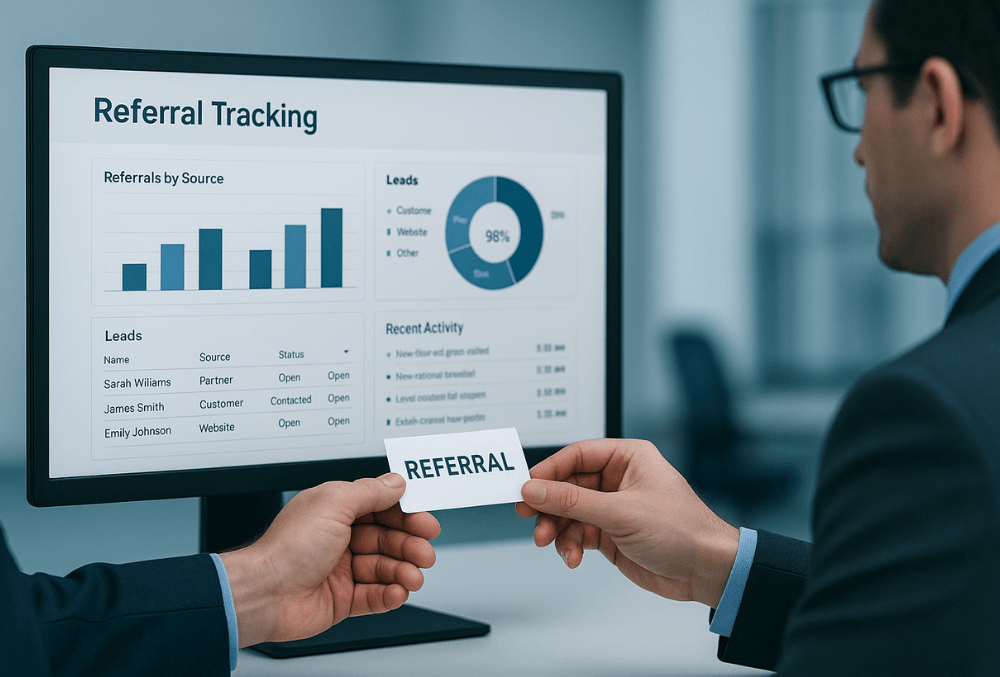B2B referral programs are one of the most effective ways to generate high-value leads, cut customer acquisition costs, and grow trust with minimal spend. By encouraging existing partners, vendors, or clients to recommend your services, you turn trusted relationships into new business opportunities.
But understanding how B2B referral programs work, and how to build one that actually drives results, requires more than just asking for referrals. It takes clear strategy, smart tools, and strong incentives.
Let’s break down the most common mistakes businesses make when building a referral program and how to avoid them.

B2B Referral Program Mistake 1: Skipping the Referral Strategy Stage
Many companies jump straight into offering rewards without first mapping out their referral strategy. A successful B2B referral program begins with a clear plan: Who are you targeting? What actions should referrers take? What counts as a successful referral?
How to Avoid It:
- Define your ideal referral partner: Are they clients, vendors, or industry peers?
- Match your offer to your sales cycle: For longer B2B cycles, consider multi-touch reward structures.
- Create referral program tiers for different partner engagement levels.
Start with a strategy that supports your overall sales and marketing goals. Without one, you’ll struggle to generate consistent, meaningful leads.
A referral strategy should also account for how your business will manage the program internally. Assign ownership to a team or individual responsible for tracking progress, onboarding referral partners, and resolving any issues that arise.
Set KPIs such as number of referrals per month, conversion rates, and average deal size so you can evaluate the program’s performance over time. Consider piloting your strategy with a small group of trusted partners to test workflows and messaging before a full rollout.
B2B Referral Program Mistake 2: Weak or Confusing Incentives
A vague “get rewarded for referring us” message won’t cut it. If your partners don’t understand what’s in it for them or if the reward feels too small to be worth the effort, they won’t engage.
How to Avoid It:
- Offer relevant incentives like cash bonuses, discounted services, or exclusive access.
- Be specific about the reward structure: Is it per qualified lead, closed deal, or another trigger?
- Consider performance-based incentives to boost volume.
At P3 Cost Analysts, we’ve found that B2B partners are more responsive to clear, tangible benefits. Simple and transparent terms go a long way.
The perceived value of your incentive must align with the effort required to refer a quality lead. For example, if your services cost tens of thousands of dollars annually, a $50 reward likely won’t spark action. On the other hand, too high a reward could devalue your brand or attract low-quality referrals.
Consider offering scalable incentives that increase with the size or quality of the opportunity. Always communicate terms clearly. Confusion leads to drop-off. A tested, thoughtful incentive structure can significantly improve participation rates.
B2B Referral Program Mistake 3: Not Using Referral Software
Manually tracking referrals through spreadsheets or emails quickly becomes messy and makes your program hard to scale. Without software, leads may fall through the cracks and partners can feel ignored.
How to Avoid It:
Invest in referral software that integrates with your CRM. Look for tools that:
- Automate tracking of referrals and conversions
- Allow real-time performance monitoring
- Send notifications and status updates to partners
- Offer dashboards for visibility and transparency
Good software keeps the referral process simple for everyone involved and ensures no opportunity is lost. It also helps you gather the data needed to optimize the program over time.
Beyond core tracking, the best referral software provides analytics that help you understand patterns over time, such as which partners are most active, where leads stall in the funnel, and what types of clients convert best.
Choose a solution that allows for easy onboarding of new partners and gives them access to self-service tools for tracking their own progress. The easier you make the process, the more likely partners will stay engaged. Scalable software is what transforms a referral program from a one-time project into a long-term growth engine.
B2B Referral Program Mistake 4: Treating Referrals as One-Offs
Some businesses run short-term referral pushes, only to let them fade away after a few months. Without consistent effort, even the best programs lose steam.
How to Avoid It:
- Make referral programs a permanent part of your sales strategy
- Regularly communicate with partners through email updates or a portal
- Recognize top-performing partners publicly (or privately, if preferred)
- Refresh the program with new incentives or tiers each quarter
Referral programs that work long-term are those that build relationships, not just transactions.
Successful referral programs are built on consistency. This includes consistent messaging, prompt follow-up with referrals, and ongoing feedback loops with your partners. Consider adding referral requests into your regular account management cadence, such as quarterly business reviews or service satisfaction surveys.
Keep your program top of mind by sending periodic reminders or sharing success stories. When your partners see that others are benefiting, they’ll be more inclined to participate. A stagnant program signals low value.
B2B Referral Program Mistake 5: Ignoring Partner Collaboration
Referral programs aren’t just a one-way request. Successful programs often involve two-way value. If you want trusted partners to bring in warm leads, you need to give them reasons to stay engaged.
How to Avoid It:
- Invite partners to co-create content or attend joint events
- Equip them with shareable assets like emails, landing pages, or case studies
- Establish a partner program that aligns with your referral strategy
Partnerships flourish when there’s mutual benefit. Consider hosting webinars, creating co-branded resources, or sharing leads in return. You might also assign partner managers who regularly check in and offer strategic insights to maximize results.
Remember, your partners represent your brand in the referral process. Equip them with talking points, value propositions, and social proof so they can promote your services confidently and accurately. Relationship-building is the secret to scaling referrals beyond your immediate network.
B2B Referral Program Mistake 6: Failing to Measure and Optimize
If you’re not tracking results, you can’t improve them. Many businesses fail to monitor which referral sources work best or how rewards affect participation.
How to Avoid It:
Set up metrics that tie directly to business outcomes, such as:
- Total number of referrals submitted
- Conversion rate of referred leads
- Average lifetime value of referred clients
- Cost per acquisition vs. other channels
Use this data to optimize rewards, update messaging, or expand to new referral partner types. The goal is to build a system that continuously improves.
In addition to quantitative metrics, gather qualitative feedback from partners and customers involved in the referral process. Ask what’s working, what’s unclear, and what could improve. This input helps you refine the user experience and address friction points before they affect engagement.
Track ROI over time, comparing cost per lead and close rate from referrals versus other marketing channels. Referral programs aren’t set-and-forget. They require iteration. But when measured and optimized correctly, they can outperform many traditional marketing methods.
B2B Referral Program Mistake 7: Not Connecting with the Right Prospects
Some referral programs cast too wide a net resulting in poor-quality leads that waste time and sales resources.
How to Avoid It:
- Educate partners on your ideal client profile
- Provide examples of good referrals vs. unqualified ones
- Offer pre-screening or pre-approval tools
This approach helps referral partners filter prospects and send you only those that are likely to convert.
The best referral partners understand not just who to refer, but when and how. Equip them with tools like lead qualification checklists or referral forms that filter out poor fits early. You can also run brief training sessions or provide FAQs to clarify expectations.
Giving partners clarity builds their confidence and reduces the time your sales team spends on unqualified prospects. Smart targeting increases efficiency, improves close rates, and ensures that every referral has a real chance of becoming a customer.
Start a Referral Program That Drives Real Growth
A strong B2B referral program isn’t just a marketing tactic, it’s a long-term growth engine. With the right strategy, clear rewards, reliable software, and ongoing engagement, you can unlock scalable savings and steady high-quality leads.
At P3 Cost Analysts, we work with businesses across the country to build referral programs that align with real financial goals. Our programs are designed for trust, transparency, and measurable impact.
Looking to grow your business with less spend and more trust? Contact P3 Cost Analysts today to learn how we can build a referral system tailored to your success.



